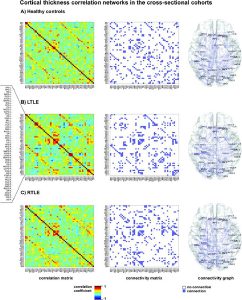Abstract
Temporal lobe epilepsy (TLE) is the most common drug-resistant epilepsy in adults. As morphometric studies have shown widespread structural damage in TLE, this condition is often referred to as a system disorder with disrupted structural networks. Studies based on univariate statistical comparisons can only indirectly test such hypothesis. Graph theory provides a new approach to formally analyze large-scale networks. Using graph-theoretical analysis of magnetic resonance imaging-based cortical thickness correlations, we investigated the structural basis of the organization of such networks in 122 TLE patients and 47 age- and sex-matched healthy controls. Networks in patients and controls were characterized by a short path length between anatomical regions and a high degree of clustering, suggestive of a small-world topology. However, compared with controls, patients showed increased path length and clustering, altered distribution of network hubs, and higher vulnerability to targeted attacks, suggesting a reorganization of cortical thickness correlation networks. Longitudinal analysis demonstrated that network alterations intensify over time. Bootstrap simulations showed high reproducibility of network parameters across random subsamplings, indicating that altered network topology in TLE is a consistent finding. Increased network disruption was associated with unfavorable postoperative seizure outcome, implying adverse effects of epileptogenesis on large-scale network organization.

